|
|
| home > files |
| Bangkok
experience. R&Sie... growing-up interview Matteo Costanzo |
| [in italiano] | Growing-up
is a developing interview with François Roche, of the Parisian studio
R&Sie... concerning the Silverelief/B-mu (1) project for a contemporary
art museum in Bangkok. The intentions of this work are to understand
how today an "extremely radical" architecture studio elaborates its
planning itinerary, ranging from conceptual research to realisation:
understanding through a series of interviews the relationship with the
client, the economic resources, the situation of action, the intervention
program, the creative strategies and the realisation; translating the
whole process that uses all kinds of elements, from measurements to
numbers, from m2 to M$, from materials to sensitivity. R&Sie... expresses a particular way of seeing and living architecture. First of all the studio logo is never the same thus going against the laws of the market; it changes at each new participant's intervention. Since 1989 it has modified like an ectoplasm in continuous motion (2). This approach is deeply tied to the possibility architecture has to disguise itself within the surrounding territory and interacting with it. After many projects and installations, as Sedimentation (3), Furtive (4) and the realisation of Judith's and Amy Barak's home Shearing (5), today R & Sie... studio confronts itself with the planning of a museum space of 5000 m2 in the city of Bangkok. [MC] NOTES: |
|||
 Sedimentation, La Baïse, 1997. 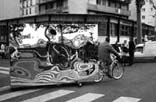 Furtive, Parigi, 1998. 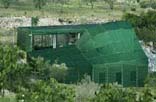 Shearing, Sommières, 2001. |
(1)
Silverelief/B-mu, Bangkok, 2002. creative team: François Roche, Stephanie Lavaux, Jean Navarro, Pascal Bertholio landscape architect: Michel Boulcourt, Parigi furniture designer: Mathieu Lehanneur, Parigi steel structural engineer: Nicolas Green, Parigi, Londra light engineer: Benoit Lalloz, Parigi client: Petch Osathanugrah, Bangkok key dimensions: 5000 m2 scenario: - random relief calculated by particles and pixelisation for a pure grey ectoplasm under the lightning grey sky of Bangkok - collecting the dust of the city ("Breeding the dust" of Duchamp...) by an aluminium envelope and electrostatics system - exacerbating the schizoid climate between interior (white cube and labyrinth in a Euclidian geometry) and exterior (dust relief on topologic geometry), and using this sun protection monolith interface for in/outdoor exhibition. (2) History of the group from 1989 to 2002: BoyeRoche 89 / Roche* 90 / Roche&François 91 / Roche, François, Lewis, Huber, Roubaud, Perrin 92 / Roche, DSV & Sie 93-97 / R, DSV & Sie .P 98 / R&Sie.D/B:L 99 -2001 / R&Sie... 2002 At this moment, as Robert Such suggests, "R & Sie..." pronounced in French is read as "hérésie" and in English as "heresy". (The three points hint to the fact that the studio is open to letting in new partners). (3) Sedimentation, La Baïse, 1997. Realisation of Tourism design on a bank of a wild river, first step production of a prototype on 5000 m2, the site of Vianne, on the river "la Baïse". commission following a competition scenario: - realisation of a plastic roof like a floating jellyfish in trees - waiting for the rising of the river - using this design like a metaphoric filter of pollution. (4) Furtive, Parigi, 1998. Realisation of a nomadic and furtive flat, 2 m2, Paris, 10th district, October/December 98. Direct commission. scenario: - realisation of a deforming mirror vehicle - displacement of this deformation in the streets of Paris - living and sleeping inside. (5) Shearing, Sommières, 2001. House for Judith and Ami Barak, Sommiéres, South of France, 150 m2, 0,15 M$. scenario: - exacerbation of the topography of the landscape - producing this building like a geography for a furtive aspect - constructing it like a tent (thermal protection). |
|||
| MATTEO
COSTANZO. First of all I would like to understand the context in which
the Silverelief/B-mu in Bangkok comes together: the more peculiar
aspects of the project, the image of the client, how he contacted you
and what budget was estimated for this operation? FRANÇOIS ROCHE. We are constructing another little project in Thailand http://www.new-territories.com/roche2002ter.htm, and I was in Bangkok a year ago drinking a Mekong, a fake hair on my head, for the first marks. At three o'clock in the morning, a little bit tired by the mix between jet lag and melatonine, I met the main art collector in Bangkok. I was with Philippe Parreno and Rirkrit Tiravanija, two friendly artists with whom I‘m doing this "Hybrid Muscle" project (in Chan Mai). Well, we are talking with some junk blood when we discovered that this interesting guy, mister Petch Osathanugrah, was wondering which architect he should invite to do the design. Koolhaas came but he was suspicious on his real value (cynic in Thailand doesn't work so well as it does in other part on the world) and he would call the following week a Japan one (not so far). 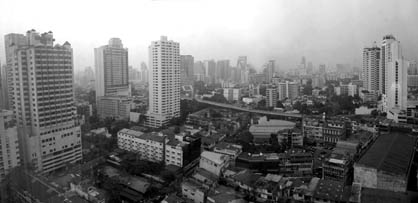 Bangkok. But I was here, just here, at the right place at the right time. Not because the French foreign office called me to be its slave VIP of the French pride, not because I won a competition since Jean Nouvel was in the jury, no, no, just a client and me. The starting point was clearly this one, with my fake hair... The budget is 5 M$ in Bangkok, which amounts to twice as much in other countries (cost of labour). What kind of experience was Bangkok as a city and a context of action? How did you create a dialogue with this city? Bangkok is a very dusty gray and luminous city. The pollution cloud, CO2 residue, filters and standardizes the light with only gray spectral frequencies. Over 50 different words could be used to describe the tones and the touching aspects of the absence of color: "luminous, vaporous, pheromonal, hideous, shaded, transpiring, cottony, rugged, dirty, hazy, suffocating, hairy...". |
[18feb2003]
|
|||
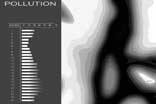 Rate of pollution. |
The
dust dresses the city and her biotope, even going so far as to modify
the climate. Within this fog of specks and particles, Bangkok becomes
the melting pot of hypertrophic human activity with convulsing exchanges
of energy, where visibility becomes its greatest charm. At the antipodes of the canons of modern urbanism and its panoply of instruments lies the city of Bangkok, ectoplasmic, super fluid to quote Kipnis. She is conceived in between aleatory rhizomes where the arborescent growth is at the same time a factor of her transformation and her operational mode. In your studio you mentioned how the city is filled with dust. Can you tell me how this aspect is interpreted in terms of planning? The relationship with Duchamp you mention in the scenario arouses my curiosity. Can you clarify this aspect? Duchamp and Man Ray did an art piece, in 1920, called "Breeding the dust". Marcel Duchamp left his "Big Glass" in his own cave for several months. The attraction of the dust was depending on the radiosity of the glass, in which they are some different types of matter (steel, oil, copper). The pictures of Man Ray are like airplane pictures of Bangkok, with some dusty monoliths. So this piece is becoming the visible icon of the failure of all XX century's concept on urbanism and architecture. 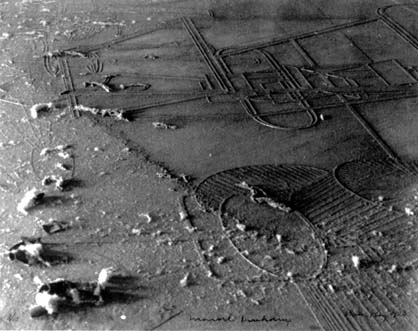 Man Ray, Dust Breeding, 1920. Detail from the Large Glass by Marcel Duchamp. Can the image of the "relief", made up of city sediments, gray sky and its dust, be interpreted as you would say as a "distortion of cartography"? |
|||
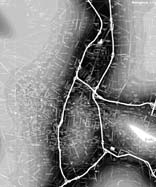 Situation. |
The cartography is not only the skin of the territory, but the
climate, the atmosphere of a situation. It’s made of flesh, blood and
pollution. |
|||
|
In Sedimentation the structure is conceived as a filter
against pollution and impurities; it is an outer layer made up of
an intersection of transparent plastic bands between the plantation
of a forest near the Blaise river. In Sharing, the Barak's
home -that is a green "furtive" tent isolated in the Sommieres countryside
in southern France- wraps up a series of cubic spaces made of white
cement. It presents itself as a land deformation but also as a thermal
protection for the organism. You have been working on the concept
of sedimentation and tent for a while. How have these two themes developed
today? |
||||
|
I'm deeply against the Guggenheim process, with its confusion between
Building and art piece in the continuum of the "modernistic promenade"
which kidnaps the interior for its own selfish value. A museum is a
perfect ambiguity between two egos, two concepts of consummation -one
from the architect, the other from art scene. This project doesn't want
to choose a position, just to create a schizoid rhizome between these
ideologies. We are talking here of two distinct geometric structures: one is Euclidian, globalization encased, where cultural merchandises are circulated in an aseptic and deteritorialized universe, and the other typology, on the other hand, is plunged in a intoxicating urban chaos. |
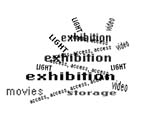 Program. |
|||
Related
to your production both the Bangkok project and the tent home project,
in some ways a mini prototype of "B-mu", develop a different strategy,
a harder treatment of space where soft and continuous surfaces are substituted
with pixelized forms made up of a multi layer composition. What is the
reason for this change? Can we say "form follows money"?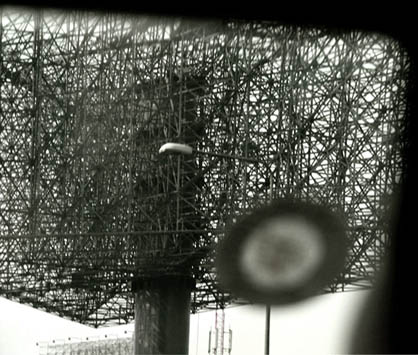 Bangkok. The project is in global evolution. Look at the work in progress... they are no "pixelisations". This was just used to show the metaphoric transformation between the pure emergencies of Pan Gna (where you could find the rock from "man of gold gun" in a perfect Rousseuism nature) and the reality of Bangkok (where all buildings "squarely and badly done" are dealing with this monolith in the gray climate of the day after). 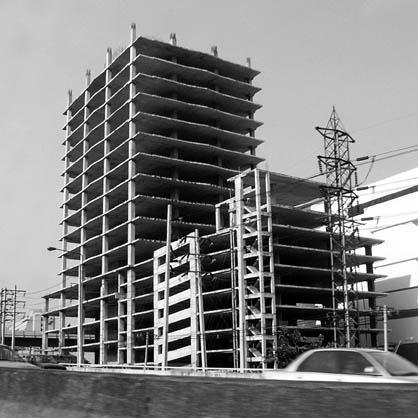 Bangkok. The eco tourism dream is coming from a OO7 background. I like Adams, the architect of the series, German himself, leaving Germany in 1937, and very addicted to Lang's Black and White, discovering the breast of Marilyn and doing some movie atmosphere between Bunker and fake nature. There is something about that in the "B-mu" project. |
||||
V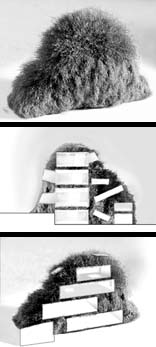 Section. |
These
cubes become homes and then contemporary art museum. You told me that
the choice of leaving the cubes plain white cement came from the artists.
You often collaborate with artists with different backgrounds. These
White Cubes have recently been the center of criticism from museum curators;
I am referring, for example, to Brian O'Doherty's essay Inside the
White Cube, or Nicholas Serota's Experience or interpretation
where spatiality is object of reflection because it prevails, in its
purity, over the image of an artist's work. Have you been able to differ
from this vision? It's not exactly White Cube, coming from the fifties, then a No Where Space, where the idea of architecture (manipulating the space) is eviscerated. We took the No Where Space like a generic morphology, like the first ingredient to prepare the cooking. How important do you think the computer will be in the execution phase? And what process do you hope to start up? For the next phase of the growing-up... Matteo Costanzo neomatteo@hotmail.com |
|||